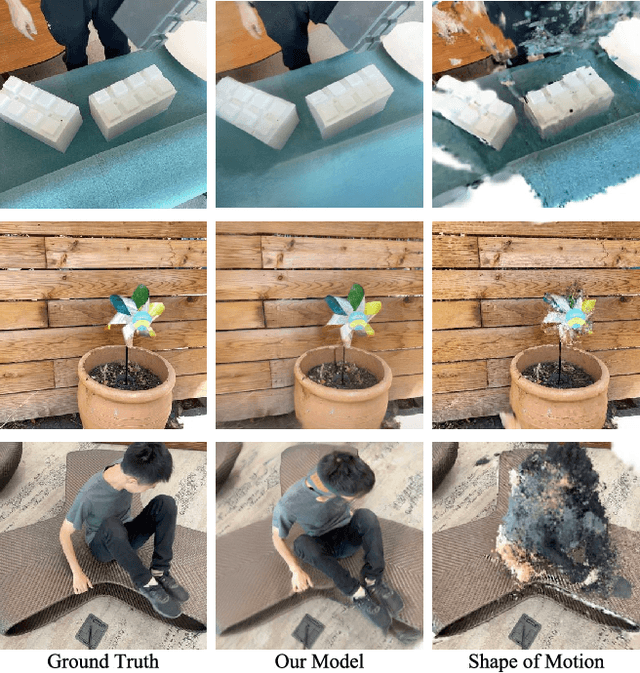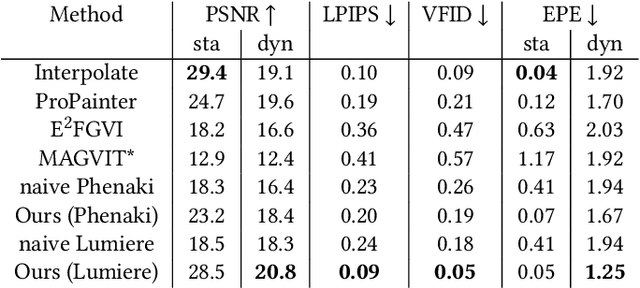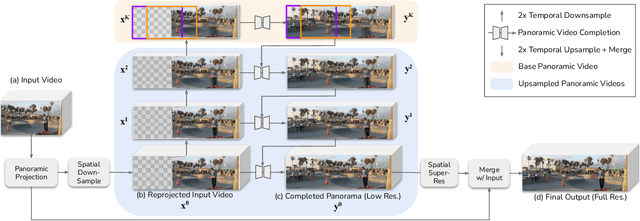Aleksander Holynski
How Animals Dance (When You're Not Looking)
May 29, 2025Abstract:We present a keyframe-based framework for generating music-synchronized, choreography aware animal dance videos. Starting from a few keyframes representing distinct animal poses -- generated via text-to-image prompting or GPT-4o -- we formulate dance synthesis as a graph optimization problem: find the optimal keyframe structure that satisfies a specified choreography pattern of beats, which can be automatically estimated from a reference dance video. We also introduce an approach for mirrored pose image generation, essential for capturing symmetry in dance. In-between frames are synthesized using an video diffusion model. With as few as six input keyframes, our method can produce up to 30 second dance videos across a wide range of animals and music tracks.
Bolt3D: Generating 3D Scenes in Seconds
Mar 18, 2025Abstract:We present a latent diffusion model for fast feed-forward 3D scene generation. Given one or more images, our model Bolt3D directly samples a 3D scene representation in less than seven seconds on a single GPU. We achieve this by leveraging powerful and scalable existing 2D diffusion network architectures to produce consistent high-fidelity 3D scene representations. To train this model, we create a large-scale multiview-consistent dataset of 3D geometry and appearance by applying state-of-the-art dense 3D reconstruction techniques to existing multiview image datasets. Compared to prior multiview generative models that require per-scene optimization for 3D reconstruction, Bolt3D reduces the inference cost by a factor of up to 300 times.
Continuous 3D Perception Model with Persistent State
Jan 21, 2025Abstract:We present a unified framework capable of solving a broad range of 3D tasks. Our approach features a stateful recurrent model that continuously updates its state representation with each new observation. Given a stream of images, this evolving state can be used to generate metric-scale pointmaps (per-pixel 3D points) for each new input in an online fashion. These pointmaps reside within a common coordinate system, and can be accumulated into a coherent, dense scene reconstruction that updates as new images arrive. Our model, called CUT3R (Continuous Updating Transformer for 3D Reconstruction), captures rich priors of real-world scenes: not only can it predict accurate pointmaps from image observations, but it can also infer unseen regions of the scene by probing at virtual, unobserved views. Our method is simple yet highly flexible, naturally accepting varying lengths of images that may be either video streams or unordered photo collections, containing both static and dynamic content. We evaluate our method on various 3D/4D tasks and demonstrate competitive or state-of-the-art performance in each. Project Page: https://cut3r.github.io/
GPS as a Control Signal for Image Generation
Jan 21, 2025Abstract:We show that the GPS tags contained in photo metadata provide a useful control signal for image generation. We train GPS-to-image models and use them for tasks that require a fine-grained understanding of how images vary within a city. In particular, we train a diffusion model to generate images conditioned on both GPS and text. The learned model generates images that capture the distinctive appearance of different neighborhoods, parks, and landmarks. We also extract 3D models from 2D GPS-to-image models through score distillation sampling, using GPS conditioning to constrain the appearance of the reconstruction from each viewpoint. Our evaluations suggest that our GPS-conditioned models successfully learn to generate images that vary based on location, and that GPS conditioning improves estimated 3D structure.
Stereo4D: Learning How Things Move in 3D from Internet Stereo Videos
Dec 12, 2024Abstract:Learning to understand dynamic 3D scenes from imagery is crucial for applications ranging from robotics to scene reconstruction. Yet, unlike other problems where large-scale supervised training has enabled rapid progress, directly supervising methods for recovering 3D motion remains challenging due to the fundamental difficulty of obtaining ground truth annotations. We present a system for mining high-quality 4D reconstructions from internet stereoscopic, wide-angle videos. Our system fuses and filters the outputs of camera pose estimation, stereo depth estimation, and temporal tracking methods into high-quality dynamic 3D reconstructions. We use this method to generate large-scale data in the form of world-consistent, pseudo-metric 3D point clouds with long-term motion trajectories. We demonstrate the utility of this data by training a variant of DUSt3R to predict structure and 3D motion from real-world image pairs, showing that training on our reconstructed data enables generalization to diverse real-world scenes. Project page: https://stereo4d.github.io
SimVS: Simulating World Inconsistencies for Robust View Synthesis
Dec 10, 2024



Abstract:Novel-view synthesis techniques achieve impressive results for static scenes but struggle when faced with the inconsistencies inherent to casual capture settings: varying illumination, scene motion, and other unintended effects that are difficult to model explicitly. We present an approach for leveraging generative video models to simulate the inconsistencies in the world that can occur during capture. We use this process, along with existing multi-view datasets, to create synthetic data for training a multi-view harmonization network that is able to reconcile inconsistent observations into a consistent 3D scene. We demonstrate that our world-simulation strategy significantly outperforms traditional augmentation methods in handling real-world scene variations, thereby enabling highly accurate static 3D reconstructions in the presence of a variety of challenging inconsistencies. Project page: https://alextrevithick.github.io/simvs
MegaSaM: Accurate, Fast, and Robust Structure and Motion from Casual Dynamic Videos
Dec 05, 2024



Abstract:We present a system that allows for accurate, fast, and robust estimation of camera parameters and depth maps from casual monocular videos of dynamic scenes. Most conventional structure from motion and monocular SLAM techniques assume input videos that feature predominantly static scenes with large amounts of parallax. Such methods tend to produce erroneous estimates in the absence of these conditions. Recent neural network-based approaches attempt to overcome these challenges; however, such methods are either computationally expensive or brittle when run on dynamic videos with uncontrolled camera motion or unknown field of view. We demonstrate the surprising effectiveness of a deep visual SLAM framework: with careful modifications to its training and inference schemes, this system can scale to real-world videos of complex dynamic scenes with unconstrained camera paths, including videos with little camera parallax. Extensive experiments on both synthetic and real videos demonstrate that our system is significantly more accurate and robust at camera pose and depth estimation when compared with prior and concurrent work, with faster or comparable running times. See interactive results on our project page: https://mega-sam.github.io/
CAT4D: Create Anything in 4D with Multi-View Video Diffusion Models
Nov 27, 2024



Abstract:We present CAT4D, a method for creating 4D (dynamic 3D) scenes from monocular video. CAT4D leverages a multi-view video diffusion model trained on a diverse combination of datasets to enable novel view synthesis at any specified camera poses and timestamps. Combined with a novel sampling approach, this model can transform a single monocular video into a multi-view video, enabling robust 4D reconstruction via optimization of a deformable 3D Gaussian representation. We demonstrate competitive performance on novel view synthesis and dynamic scene reconstruction benchmarks, and highlight the creative capabilities for 4D scene generation from real or generated videos. See our project page for results and interactive demos: \url{cat-4d.github.io}.
VidPanos: Generative Panoramic Videos from Casual Panning Videos
Oct 17, 2024



Abstract:Panoramic image stitching provides a unified, wide-angle view of a scene that extends beyond the camera's field of view. Stitching frames of a panning video into a panoramic photograph is a well-understood problem for stationary scenes, but when objects are moving, a still panorama cannot capture the scene. We present a method for synthesizing a panoramic video from a casually-captured panning video, as if the original video were captured with a wide-angle camera. We pose panorama synthesis as a space-time outpainting problem, where we aim to create a full panoramic video of the same length as the input video. Consistent completion of the space-time volume requires a powerful, realistic prior over video content and motion, for which we adapt generative video models. Existing generative models do not, however, immediately extend to panorama completion, as we show. We instead apply video generation as a component of our panorama synthesis system, and demonstrate how to exploit the strengths of the models while minimizing their limitations. Our system can create video panoramas for a range of in-the-wild scenes including people, vehicles, and flowing water, as well as stationary background features.
Generative Inbetweening: Adapting Image-to-Video Models for Keyframe Interpolation
Aug 27, 2024Abstract:We present a method for generating video sequences with coherent motion between a pair of input key frames. We adapt a pretrained large-scale image-to-video diffusion model (originally trained to generate videos moving forward in time from a single input image) for key frame interpolation, i.e., to produce a video in between two input frames. We accomplish this adaptation through a lightweight fine-tuning technique that produces a version of the model that instead predicts videos moving backwards in time from a single input image. This model (along with the original forward-moving model) is subsequently used in a dual-directional diffusion sampling process that combines the overlapping model estimates starting from each of the two keyframes. Our experiments show that our method outperforms both existing diffusion-based methods and traditional frame interpolation techniques.
 Add to Chrome
Add to Chrome Add to Firefox
Add to Firefox Add to Edge
Add to Edge